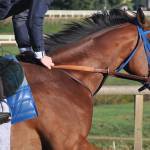Multitasking: Is Breeding Race Mares a Good Idea?

Though no specific research has been conducted on the subject, there are many stories of racing fillies and mares that have shown significantly better race results after being bred and settling into early pregnancy. Is there some magic formula that accounts for this improvement, or do winning mares just make a better story than those who may actually lose form and speed after being bred?
Consider the case of Spain, a mare that won the Grade II Fleur de Lis Handicap at Churchill Downs while in foal to Storm Cat. Spain had won at lower grades prior to being bred. Eventually winning more than $3.5 million dollars in her American racing career, Spain retired from the track to produce stakes-winning offspring.
In another story, Redstone Dancer struggled to place fifth in a low-level stakes race before being bred, after which she won two Group III races including the EBF Brownstown Stakes in Ireland.
In both England and the United States, pregnant mares and fillies are allowed to race up to 120 days of gestation. Exercise is necessary and beneficial to healthy horses, and race training in the first four months of pregnancy is generally accepted as harmless.
Some trainers feel the improvement in race performance may be related to cessation of heat periods after a filly or mare is bred. In some horses, coming into season in the spring is accompanied by nervousness, temperamental behavior, lack of concentration, and even metabolic problems such as tying-up. Pregnancy puts an end to the mare’s cycle, allowing her behavior to smooth out so that she can train more consistently.








